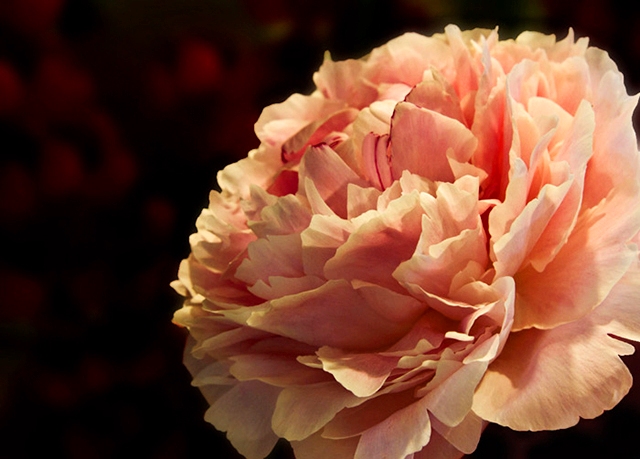
Old-world Floral
Victoria, British Columbia
Flowers are works of art that stand alone as beautiful creations of nature. The study and variety of flowers as art has gone on from the beginning of time and will, I’m convinced, keep you intrigued to the end of time. So as photographic artists, how can we make our images as unique and special as the flower themselves?
Composition: Show Their Intimate Nature
1. Depending on the flower and the color, one can achieve an old-world, intimate look.
2. By placing the flower at a diagonal and by almost filling the frame, the viewer can truly focus on the subject.
3. Through their implied fragrance, they pull you closer.
4. Through their color, they evoke an emotion.
5. Through their delicate petals, they beg to be touched.
A picture is not thought out and settled beforehand. While it is being done it changes as one’s thoughts change. And when it is finished, it still goes on changing, according to the state of mind of whoever is looking at it. A picture lives a life like a living creature, undergoing the changes imposed on us by our life from day to day. This is natural enough, as the picture lives only through the man who is looking at it. — Pablo Picasso (1881 – 1973)
Photographers talk about having a “good eye.” Whenever someone says that about my work, my feathers fluff up just a bit and my ego goes into high gear. But how is that wonderful quality, skill or technique of being able to see developed? Or is it a gift at birth? And just exactly how does having that “good eye” fit into our development as photographers.
When we present our images to others, there is a quality that can make them stand out from any other work. They are a visual presentation of what we saw, what we felt, and what we knew. Images need to be technically sound, but they also need to have strong organization and design. They need to have impact. They need to be an expression of the artist’s individual creativity. They need to be memorable. It is a tall order, but don’t allow this task to overwhelm you.
You don’t have to be another Rembrandt …
Many photographers describe themselves as “fine art” photographers. This expression has become a buzzword. But does it actually mean anything?
As a photography instructor, rather than placing a student’s emphasis on “fine art”, I encourage them to pay attention to their pleasure, their unique creativity and the expression of their inner feelings.
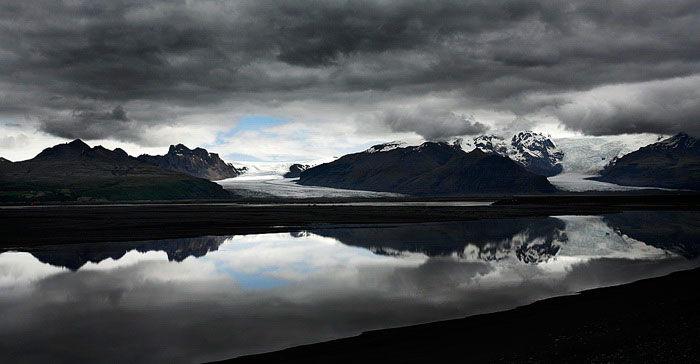
Iceland Landscape
There are many elements of design that when worked on as individually as well as an integrated group can add even more drama to an image.
Composition:Elements of Design
1. Color and contrast: Although there is just a dab of color in this image, the stark contrasts make it compelling.
2. Light: Careful handling of the light on the glacier as well as in the reflections keep the image from going too dark and dreary.
3. Shapes and Forms: There was great majesty in the volcanic mountains and the ice of the glaciers. Being aware of shapes and forms adds a sense of order to the image.
4. Placement of objects: By putting my horizon slightly above the center and keeping the lines of the reflections and land simple, I could emphasize the unbelievably primitive sense of space in nature.
5. Lines: By using the diagonal shore line and watching the reflection of the mountain to the right, I could use those lines to focus in on the light on the glaciers and clouds and move your eye across the image.
So many of the people we now consider masters in the creative visual art world, worked against the popular trends of their day. Few artists of this caliber were successful in their own time. Many died without ever knowing a touch of fame or fortune. They worked so very hard, were isolated or laughed at, but they did it because “they had no other choice … they had to.”
So, let’s put the “fine art” myth to rest for a bit and let’s actually go back to learning from the master’s such as Rembrandt, van Gogh or Gainsborough. You may wonder why I, as a photographer, would study those masters when I have the photographs of Ansel Adams or David Munich or Edward Weston from which to study? Well, that is an easy question to answer. We aren’t going to limit ourselves to studying just one level of mastery; we are going to begin a life study of all of them.
Go on working, freely and furiously; you will make progress and sooner or later your worth will be recognized, if you have any. Above all, don’t sweat over a picture. A strong emotion can be jotted down at once: dream about it and seek to express it in its simplest form. – Paul Gauguin (1848-1903)
Two Sunflowers by Van Gogh (1887)
This is a wonderful image rich in color, passion and movement. Van Gogh did many sunflower paintings but this one was the first in a large series of sunflowers.
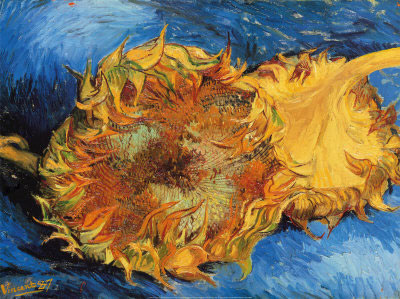
Composition: Study the Masters
1. Your eyes are moved in and out of the image with the strong stalks of the flowers.
2. By showing only the back of one of the flowers and by placing it partially behind the other one it becomes the secondary object to the large sunflower (subject).
3. The flowers were placed on the diagonal–a strong compositional key element.
4. He used vibrant color. The two strong primary colors of blue and yellow as well as touches of the complimentary colors orange and green keep your eye within the circle of the large sunflower.
5. The circular and directional brush strokes in the background keep the eye moving around the subject and the entire painting.
You don’t have to be another Rembrandt … you just have to see like one!
Art, whether cave drawings, paintings, photography, or the latest digital innovations, is about human activity and is not a mechanical activity. We can use the latest methods, techniques, equipment and devices to create, but the bottom line is that art is human.
And, what we do and how we express our creative vision is an expression of our human inner feelings. So, this makes art and the study of old masters as important today as it was years ago. This study is as applicable to the computer, as it was to early man who left details of his life on ancient walls. We may not know who his “masters” were, but you can bet that he had them. When someone saw his drawings and added to them or improved upon them with their own creativity, they communicated, and then stepped past just communicating, into an artistic medium just for the sake of creating.
In other artistic endeavors, such as music, we have no early recordings of Beethoven or Mozart playing their work. The musician has to go by the written and rely on his own ability to interpret. In visual arts, however, we are so fortunate to have the originals to study. We can see exactly what they did, along with the how and why.

Shadows
Helsinki, Finland
I couldn’t help but notice those feet and shadows.
Composition: Narrow the Focus
1. Learn to follow through when you see something of interest, such as these fantastic textures and long shadows that were produced by the late afternoon, low on the horizon light.
2. Look and interpret the scene in a way that is unusual.
3. When something screams at you to stop and look more closely, pay attention. You don’t want to miss something special.
4. By simplifying our photographs to the very basic features, we can more effectively draw our viewer into our images and share with them what we see.
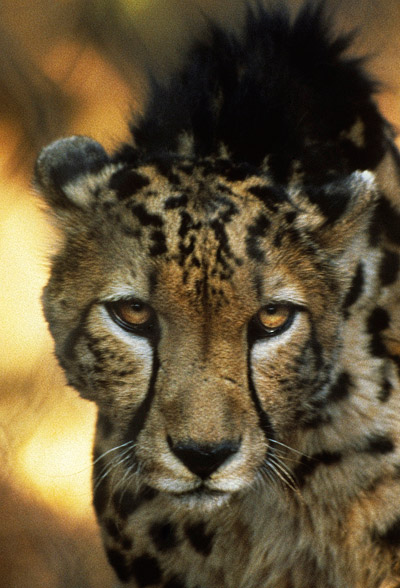
Cheetah
De Wildt Cheetah Reserve
near Pretoria, South Africa
There was something so compelling about this large cat, that I had difficulty tearing myself away. With animals, as with people, one needs to focus on the eyes. They tell the story.
Composition: Focus
1. A blurred background keeps your attention on the subject.
2. The backgrounds golden orange light enhances the color of the Cheetah’s eyes.
3
. Tight cropping forces the viewer to be locked into the focal point of the image, the intense eyes.
4
. Capturing the catch light, color, details and contrast in the eyes keeps the viewer looking into them.
Are we born with a “good eye” or can it be acquired?
It is my opinion that we are both born with the ability to “see” and express ourselves artistically and that we also have the ability to learn to “see”. Seeing is noticing details. Sometimes it is intuitive, and other times it is not. I think the big difference comes in our ability to break out of being unaware and into super awareness. Have you ever seen a hungry animal tracking prey? Because they are working at finding sustenance, they become super aware of every noise, every whisper of sound in the bush, and every smell or movement around them. I like to say that they become “gamy.”
Photographers who are intently aware of their surroundings, work on finding their vision, and then translating that vision into a photograph also become “gamy”. They notice the edges of light, the contrasts and the similarities in subject and background objects. They look at a variety of angles and weigh the design merits of what they see. Their concentration is focused, and if you were to ask them specifically what they were seeing or doing, they might be so focused that they are unable to answer you. In order to have a “master’s eye”, this is the kind of focus that is demanded.

Abstract–Con Trail at Dawn
Mono Lake, California
Learn to look at things not the way you preconceive and want them to be, but as they are. Be prepared for the unexpected opportunity. Get flexibility in your fingertips as you reach for your camera so that you will know exactly what to do when that opportunity arises.
Composition: Abstract Motion
1. The vibrant orange glow of the sunrise draws the viewer’s attention.
2. By combining elements created by man and nature one can create dual feelings of both competition and harmony.
3. By placing the con trail at a diagonal you get the sensation of motion as it pulls your eyes in, across and out of the frame.
4. The shadow of the trail on the high clouds creates the necessary separation and contrast.
He must also spend time looking at the works of the masters, so as to train his eye and his judgment. In this way he will be able to put into practice what he has been taught.
– Leonardo da Vinci (1452-1519) Advice to a young student.
How to acquire a “master’s eye”…
Have you ever gone to a museum and stood before a painting in awe and wondered what it was that made this art so special, and why the maker is called a master? Many years ago, when I was struggling with art and painting classes, one of my instructors told me to find the book called Painting Techniques of the Masters, by Hereward Lester Cooke. He was the Curator of Painting at the National Museum of Art. His book takes a famous painting and analyzes a small section, a technique, or even a method of brush stroke. Mr. Cooke breaks apart the whole and talks about why the painting works.
As an example, Mr. Cooke takes the painting of Giovanno Antonio Boltraffio’s (Milanese 1467-1516) Portrait of a Youth and analyzes the way the painter uses his mastery of light and shade to make the portrait wonderfully three-dimensional. But, Mr. Cooke points out that there is more than the mastery of light and shading. There is the subtlety of slightly altering the value of the shadows to change the expression. In this painting, the shadows are deepened under the lip, at the corners of the mouth, and under the nostrils. This subtle change of accent in these shadows creates a feeling of resentment and sorrow. Now, how can we translate what we just learned from Boltraffio to our photography? What is the lesson here?
Portrait of a Youth by Giovan Antonio Boltraffio (about 1495-1498)
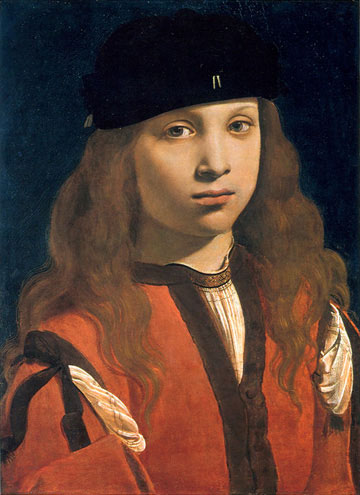
Why is it important to study other examples of art and photography? I study these Masters to see the subtleties that they emphasized and to understand what they were trying to express. It is all a part of learning to see and learning to make creative decisions in a more spontaneous way.
Composition: Study More
1. Learn to make decisions quickly.
2. Work intuitively so that you feel the image in your fingertips.
3. Create by making good selections.
4. Without intense studying you won’t see the many options from which you can choose.
5. My camera becomes an extension of my fingers just as Boltraffio’s brush became an extension of his fingers.
6. Studying, thinking, experimenting, and re-studying are all part of learning to see with the eye of a master.
The best way for the student of photography to proceed is to view images of the photographic masters and see how they manipulate the light to bring subtle changes to the expression of the subject. Whenever you look at work produced by Ansel Adams, or other photographic masters, try to understand what made them stop at that particular point to photograph that particular scene or flower or nude in a particular way. Don’t just admire the image, but try to look for the subtleties, the hints, and the small differences that make one image dynamic and masterful and another one just so-so. Reach into their minds and past their techniques to see if you can feel what they might have been feeling. Go for the human angle of presentation and communication.

Icelandic Puffin
I sat quietly in absolute wonder as these small and elegant birds popped up and strolled casually along the very edge of the cliff.
Composition: Quiet Yourself
1. Quiet yourself inside, learn to sit absolutely still.
2. Become super aware of your surroundings.
3. Open your eyes to see the small miracles of nature begin to unfold.
4. Know what you need to do ahead of actually doing it.
5. Study your subject, your location and anticipate your opportunities.
6. Be prepared for the small miracles by having your camera preset for the conditions and then learn to wait for the moment very quietly.
Then, try your hand at being a “master.” If you are into people photography, find a willing subject and have them sit very quietly for you. Have them keep a relaxed expression on their face. Move and manipulate the light to add those subtleties to their expression. Take a number of shots and make notes on what you were trying to achieve and what you did. Then, when your finished, analyze what worked and what didn’t work. Even if you don’t detect the differences, or if you feel the experiment didn’t succeed, you will find out that you did learn from it.
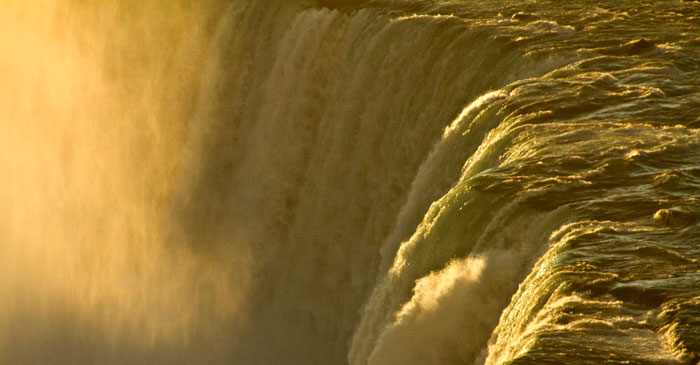
Dawn at Niagara Falls
Overlooking Horseshoe Falls, Ontario, Canada
There is something so powerful about large waterfalls. As the sun came up, the falls were almost obscured by the mist. I wanted to capture the sense of that majestic power.
Composition: Emphasizing the Subject
1. Decide what it is that you want to say or to show the viewer. Will it be the roar, the mist, the thrill as massive amounts of water take the plunge over the cliffs and break up on the large rocks at the base of the falls?
2. Narrow it down to the essence. When the whole scene is magnificent, but too big, limit yourself to a small part of the scene for more impact.
3. Be aware of the light and how it affects the subject. Anticipate the light, your exposure and your shot, before it changes.
4. Learn to be prepared and then to wait for the moment.
Another good way to learn to see is to take a class at your local museum or take a tour. Learn to look at what you are seeing. Visit art galleries. Go online or to libraries and bookstores to review photographs. But don’t be passive about looking at the variety of images you will see. Learn to see in detail, wonderful specific detail! And that is how you develop a “master’s eye”.
by Noella Ballenger
All text and photos: © 2011 Noella Ballenger. All Rights Reserved.

Leave a Reply